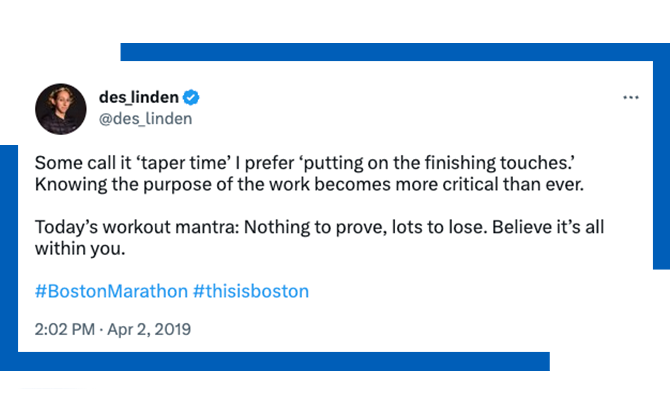Tapering with Des Linden

The 2018 Boston champ shares her tips and strategies for the “finishing touches” of your marathon training plan.
Some like to call it tapering, but I prefer putting on the finishing touches. That’s what I said in a tweet way back in 2019, and it’s how I like to think of the last few weeks of training before a race.

If this is your first time putting in the work for marathon training, you may not be familiar with the term “tapering.” It has nothing to do with pants, and everything to do with lowering the intensity and load at the end of your training program. The two- to three-week period is vital to prepare your body and mind for race day. If you skip the taper and continue with your previous training intensity, you can put yourself at risk for injury and not being physically or mentally ready for your marathon.
In this Brooks-approved, 18-week plan for marathon newbies, the first week is your lightest load at 12 miles. Your biggest load is week 15 at 57.5 miles, and your last three weeks of training are 51, 49.5, and 50.2 miles. Mileage decreases at the end, but it isn’t that significant drop from your biggest week. You’re still working hard but at a lowered intensity.


Put yourself in a place to use these final few weeks as a dress rehearsal for the first 18 miles of your upcoming marathon. Here are some key points to remember about the taper:
Cut back your workload but don’t eliminate everything
You’re not adding anything to the fitness bank in the last 10 days, but your body does crave routine. Scale back some volume and intensity but don’t eliminate it from the schedule. This will help you maintain fitness and keep your body in its natural work rhythm.
Dial in nutrition
Ideally, you’ve done this throughout the build, but if you haven’t, 2–3 weeks still gives you time. Start practicing with what you think you’ll want to have for a pre-race breakfast. And try your night-before meal before your last long run or big session. See how everything sits in your belly and adjust if needed.
On-course fueling
Like nutrition, this should be dialed in throughout the buildup. If you haven’t dialed it in, now is the time to fine tune. Use your long run or last big session to trial the electrolyte drink that’s offered on the course and/or the gels you’re planning on using.

Mental tools
Revisit the training you’ve done during the buildup. Holy smokes, you’ve come so far! Appreciate your progress and notice how you responded to training while managing your busy life schedule. Take confidence in the work you put in and trust that on race day with fresh legs you’ll be able to go the distance.
Make a race expo plan
Take a little time before you head out to the race to plan for your sightseeing and expo experience. All the events on race weekend are awesome but can be overwhelming. Set time limits and boundaries ahead of time for how long you’re willing to spend in the expo and how far you’re willing to walk around exploring — then stick to them.
It’s also crucial to make time and space for yourself in these final few weeks. A marathon is a huge mental test, so be kind to yourself. Yes, stick to your training, but don’t forget to pursue your hobbies, have some beers if that’s your thing, and enjoy the taper.
